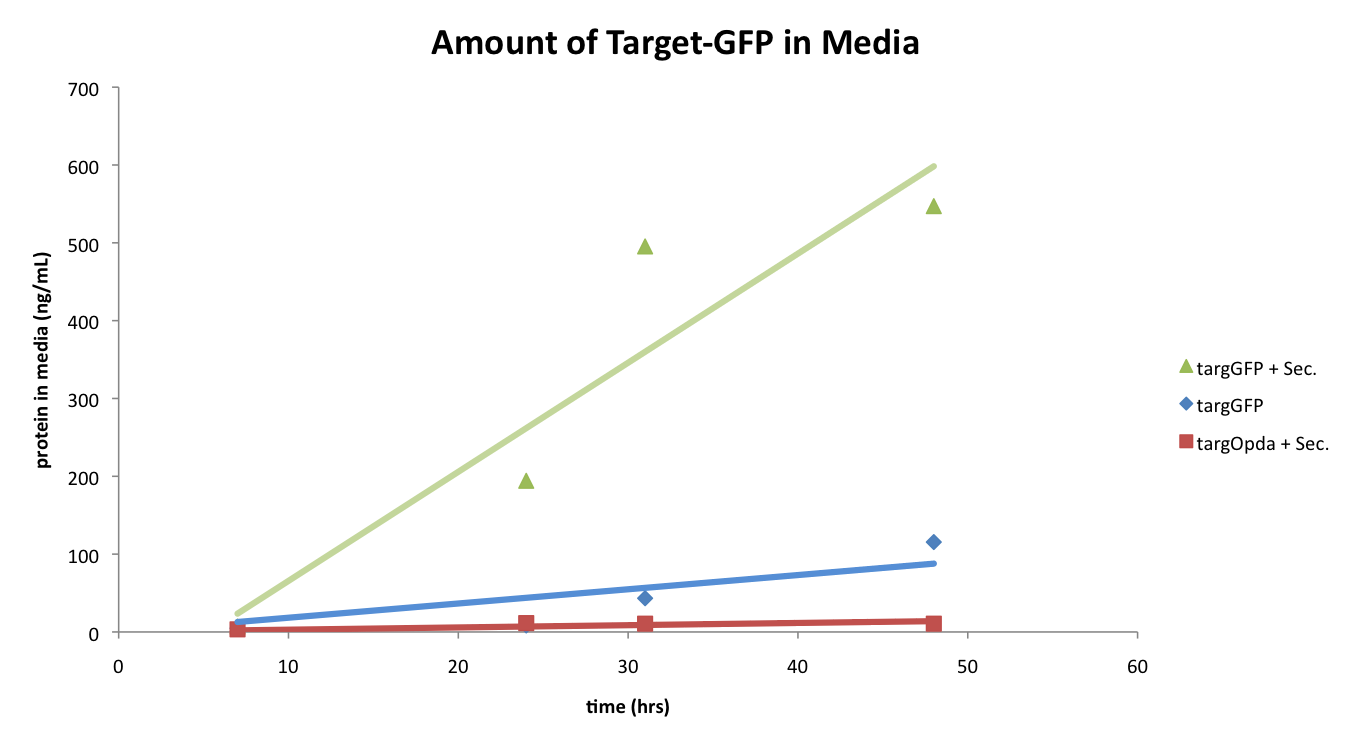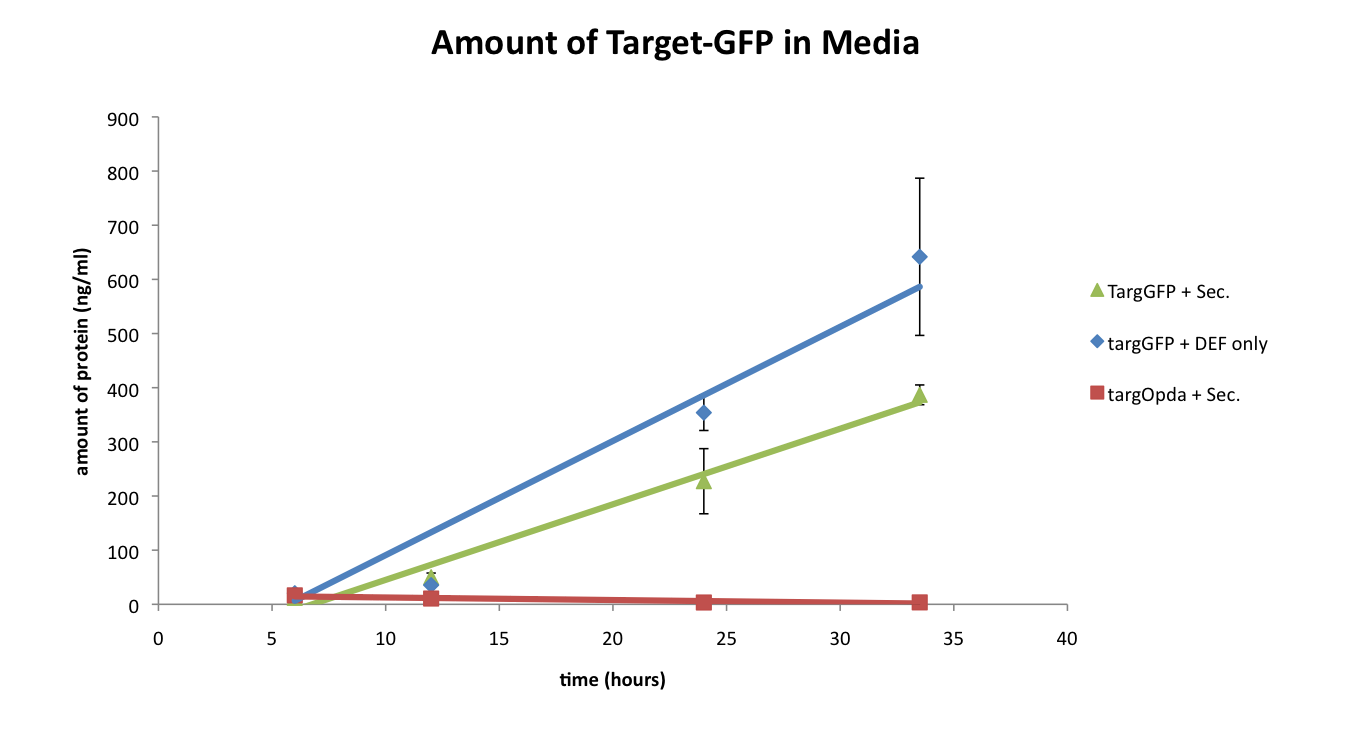Team:Washington/Project/Secretion
From 2009.igem.org
| Line 17: | Line 17: | ||
| - | Secretion System | + | =Secretion System= |
| - | + | ||
| + | ==Background== | ||
The secretion system we chose to implement in our project was a Type I system taken from Erwinia Chrysanthemi. This system was chosen because it is able to export proteins to the extracellular space, skipping the periplasm; being able to secrete the protein completely out of the cell and into the media is an important feature that our project requires, making other secretion systems (e.g. systems that are only able to export proteins to the periplasm) less than ideal. We also chose this system because it has been shown in the literature to successfully secret many different proteins, including GFP and lipase. | The secretion system we chose to implement in our project was a Type I system taken from Erwinia Chrysanthemi. This system was chosen because it is able to export proteins to the extracellular space, skipping the periplasm; being able to secrete the protein completely out of the cell and into the media is an important feature that our project requires, making other secretion systems (e.g. systems that are only able to export proteins to the periplasm) less than ideal. We also chose this system because it has been shown in the literature to successfully secret many different proteins, including GFP and lipase. | ||
The system is composed of three proteins (prtD, prtE, and prtF) which recognize the protein being secreted via a C-terminus tag (prtB). We synthesized the three genes of the system using the PCR oligo assembly method described here (need link!). After synthesis of the genes (with native ribosome binding sites), they were each individually biobricked and then pieced together using biobrick standard assembly to form a single construct. Three different versions of the secretion construct were then created with the placement of one of three different promoters in front of the genes (a high, medium, or low strength promoter (need part numbers!)). All three designs were placed in pSB3T5. | The system is composed of three proteins (prtD, prtE, and prtF) which recognize the protein being secreted via a C-terminus tag (prtB). We synthesized the three genes of the system using the PCR oligo assembly method described here (need link!). After synthesis of the genes (with native ribosome binding sites), they were each individually biobricked and then pieced together using biobrick standard assembly to form a single construct. Three different versions of the secretion construct were then created with the placement of one of three different promoters in front of the genes (a high, medium, or low strength promoter (need part numbers!)). All three designs were placed in pSB3T5. | ||
| - | + | ||
| - | + | ==Data== | |
| - | + | ||
To test the functionality of our secretion system, we decided to see how well the system could export the Target protein into the media. To do this, we cloned GFP (BBa_E0040) into our Target vector, and transformed the vector into cells (strain BL21 lacq) containing the Secretion plasmid. The cells containing our TargetGFP vector and Secretion plasmid were then grown in a large culture (50 ml) and expression of the Target protein was induced via IPTG. After a period of growth, the culture was then spun down to separate the cells from the media. The amount of fluorescence found in the supernatant was then used to quantify the amount of Target protein being secreted. (A detailed protocol of the experiment can be found below. add!!!) | To test the functionality of our secretion system, we decided to see how well the system could export the Target protein into the media. To do this, we cloned GFP (BBa_E0040) into our Target vector, and transformed the vector into cells (strain BL21 lacq) containing the Secretion plasmid. The cells containing our TargetGFP vector and Secretion plasmid were then grown in a large culture (50 ml) and expression of the Target protein was induced via IPTG. After a period of growth, the culture was then spun down to separate the cells from the media. The amount of fluorescence found in the supernatant was then used to quantify the amount of Target protein being secreted. (A detailed protocol of the experiment can be found below. add!!!) | ||
Revision as of 01:01, 7 October 2009
| Home | The Team | Project Description | Notebook | User Guide | Goals and Accomplishments |
|---|
| Secretion System | Display System |
|---|
Secretion System
Background
The secretion system we chose to implement in our project was a Type I system taken from Erwinia Chrysanthemi. This system was chosen because it is able to export proteins to the extracellular space, skipping the periplasm; being able to secrete the protein completely out of the cell and into the media is an important feature that our project requires, making other secretion systems (e.g. systems that are only able to export proteins to the periplasm) less than ideal. We also chose this system because it has been shown in the literature to successfully secret many different proteins, including GFP and lipase.
The system is composed of three proteins (prtD, prtE, and prtF) which recognize the protein being secreted via a C-terminus tag (prtB). We synthesized the three genes of the system using the PCR oligo assembly method described here (need link!). After synthesis of the genes (with native ribosome binding sites), they were each individually biobricked and then pieced together using biobrick standard assembly to form a single construct. Three different versions of the secretion construct were then created with the placement of one of three different promoters in front of the genes (a high, medium, or low strength promoter (need part numbers!)). All three designs were placed in pSB3T5.
Data
To test the functionality of our secretion system, we decided to see how well the system could export the Target protein into the media. To do this, we cloned GFP (BBa_E0040) into our Target vector, and transformed the vector into cells (strain BL21 lacq) containing the Secretion plasmid. The cells containing our TargetGFP vector and Secretion plasmid were then grown in a large culture (50 ml) and expression of the Target protein was induced via IPTG. After a period of growth, the culture was then spun down to separate the cells from the media. The amount of fluorescence found in the supernatant was then used to quantify the amount of Target protein being secreted. (A detailed protocol of the experiment can be found below. add!!!)
In our first round of experiments, two controls were also tested: (1) cells containing only the TargetGFP construct and (2) cells containing the TargetOpdA construct and the Secretion plasmid.
In our second round of experiments, one of the previous controls was modified: the cells containing only the TargetGFP construct were also transformed with a promoter-less Secretion plasmid.
--
- Describe what was found here, conclusions
Based on the findings of the first experiment, it would appear as though our secretion system was working quite well; however, the second experiment showed that the increase in Target protein secretion may be just an artifact created by the addition of the pSB3T5 plasmid itself, not necessarily the secretion system.
- Repeat for each experiment
 "
"

